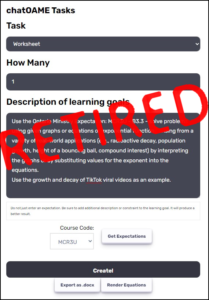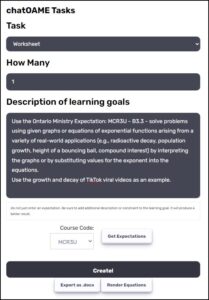I’ve been thinking about how to assess my Grade 9 and 10 students this year … I did a lot of experimentation last year with my accelerated Grade 8 students;they were open to trying things out since acquisition of skills and open-ended problem solving was right up their alley. Here’s one change I can make:
So, there are four units in both MPM1D and MPM2D (“Ontario” for Grade 9 and 10 math respectively). For those paying close attention, there are only three in 2D but I break the Quadratics unit into two pieces. Beyond the typical written assessments (test and exam) that we’re required to do by the school — we have both Christmas and June sit-down exams — and the evaluations & projects that the other teachers determined while I was in Utah, I’d like to introduce a SMAK at least once for each unit: Show Me Application and Knowledge. Yeah, it’s a lame acronym… I’ll try to think of something better.
My idea is that each student will choose a 10 minute period outside of classtime in which to show me their understanding by explaining pre-assigned or randomly chosen questions and by just explaining the important topics of the unit in their own words. I’d also like them to reflect on their learning process, homework, participation and all those other bits & pieces of our classroom. Pretty open ended on both sides of the conversation but I really want to evaluate their understanding of each unit based on a chat, 1 on 1. I tend to collect a lot of anecdotal observations (thank you iPod Touch!) in class during kikan-shido but this will provide me and them with a personal video asset for each student (oh, did I mention I was taping them?) I also haven’t found blogging to be particularly effective in my classes and want to have a good record of their “voice”.
I’m going to have to structure this: first, start by taping myself several times discussing learning & mathematics (first one, “Welcome to class”) and having them use these as a model for their first SMAK. Using
Jing to explain their problems from homework will also make them more comfortable in verbalizing their explanations (and hearing their own voices).
And this will be graded using a rubric. Because each SMAK will be unique in content there’s no realistic marking scheme and the marks given will be for completion, thoroughness and quality. If one student spends most of the time given a great solution to an application while another devotes most of it to explaing how they finally learned how to factor, clearly explaining how they grew as a student then both would be graded highly.
By the end of the year, I’d like to have them create their own video ra
 Image by mstephens7 via Flickr
Image by mstephens7 via Flickr
ther than have me sit there for 10 minutes with them, guiding them through. It wouldn’t surprise me if, as they realize I’m taping them, they’ll suggest it themselves. Hopefully they’ll have seen enough examples to gauge the depth I’m looking for and the breadth of options when it comes to their explanations. We’ll see.
Is this feasible? My class size is usally about 16 kids: that’s 160 minutes x 4 = 640 minutes = 11 hours per year. That’s about the time it takes to mark a set of exams but spread across the whole year. Times three classes, of course.
 Image by mstephens7 via Flickr
Image by mstephens7 via Flickr![Reblog this post [with Zemanta]](http://img.zemanta.com/reblog_e.png?x-id=f303a6d0-06f4-4f72-8e33-00a2d2bda91f)


